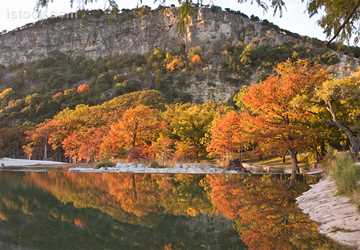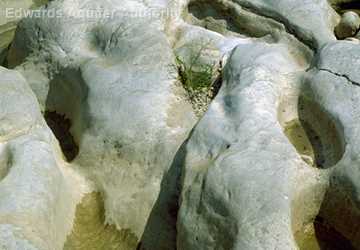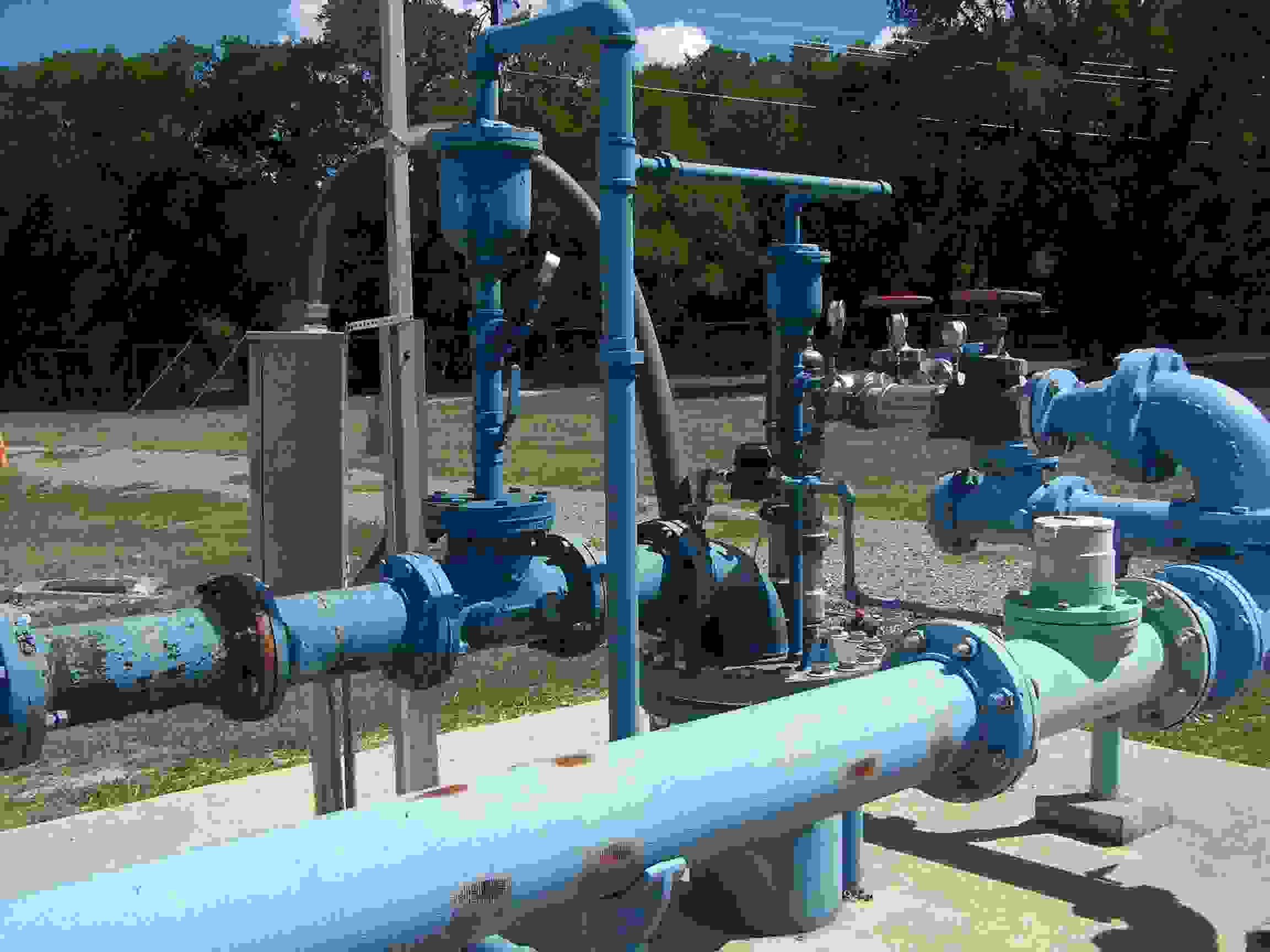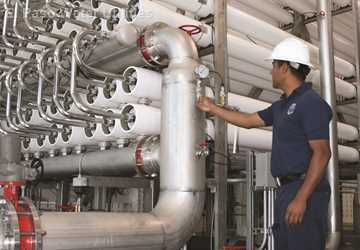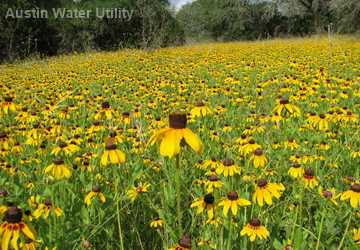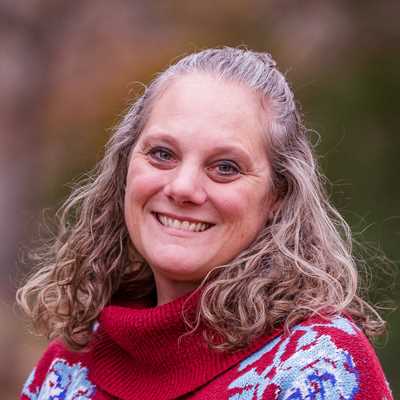Aquifer storage and recovery (ASR) has been described as an “easy” answer to “more” water by taking excess water, injecting it into aquifers and then pulling it back out in times of need, such as during drought. While some states to the east and west widely use ASR, that is not the case in Texas.
“In the 2012 Texas state water plan, ASR is only listed as 0.9 percent of new water resources — which is kind of disappointing,” said Dr. Calvin Finch, director of the Water Conservation and Technology Center. The center is administered by the Texas Water Resources Institute and Texas Center for Applied Technology.
“ASR is desirable because the storage is underground, and there’s no evaporation. Environmentally, it doesn’t change the surface of the land. With a surface reservoir, those are big issues — evaporation and environmental challenges,” he said.
Dr. Robert Mace, Texas Water Development Board (TWDB) deputy executive administrator for water science and conservation, said ASR shows up in six of the 16 regional water planning groups’ plans as a future water management strategy, but out of all the projects listed in the state water plan, ASR only accounts for about 81,000 acre-feet per year by 2060.
ASR is desirable because the storage is underground and there's no evaporation.
Although many communities are looking into ASR, currently there are two main, successful ASR locations in Texas: San Antonio and Kerrville.
Even though it is not common in Texas, current research and growing interest has some water experts optimistic about the state’s future of ASR.
Current ASR in Texas
“San Antonio Water System takes the excess permitted water from the Edwards Aquifer — a karst, limestone aquifer that is very erratic — when water levels are high and pumps it into the sand Carrizo Aquifer south of San Antonio, where it’s more stable,” Finch said. “Right now San Antonio Water System has about 90,000 acre-feet stored; its potential is about 120,000 acre-feet.”
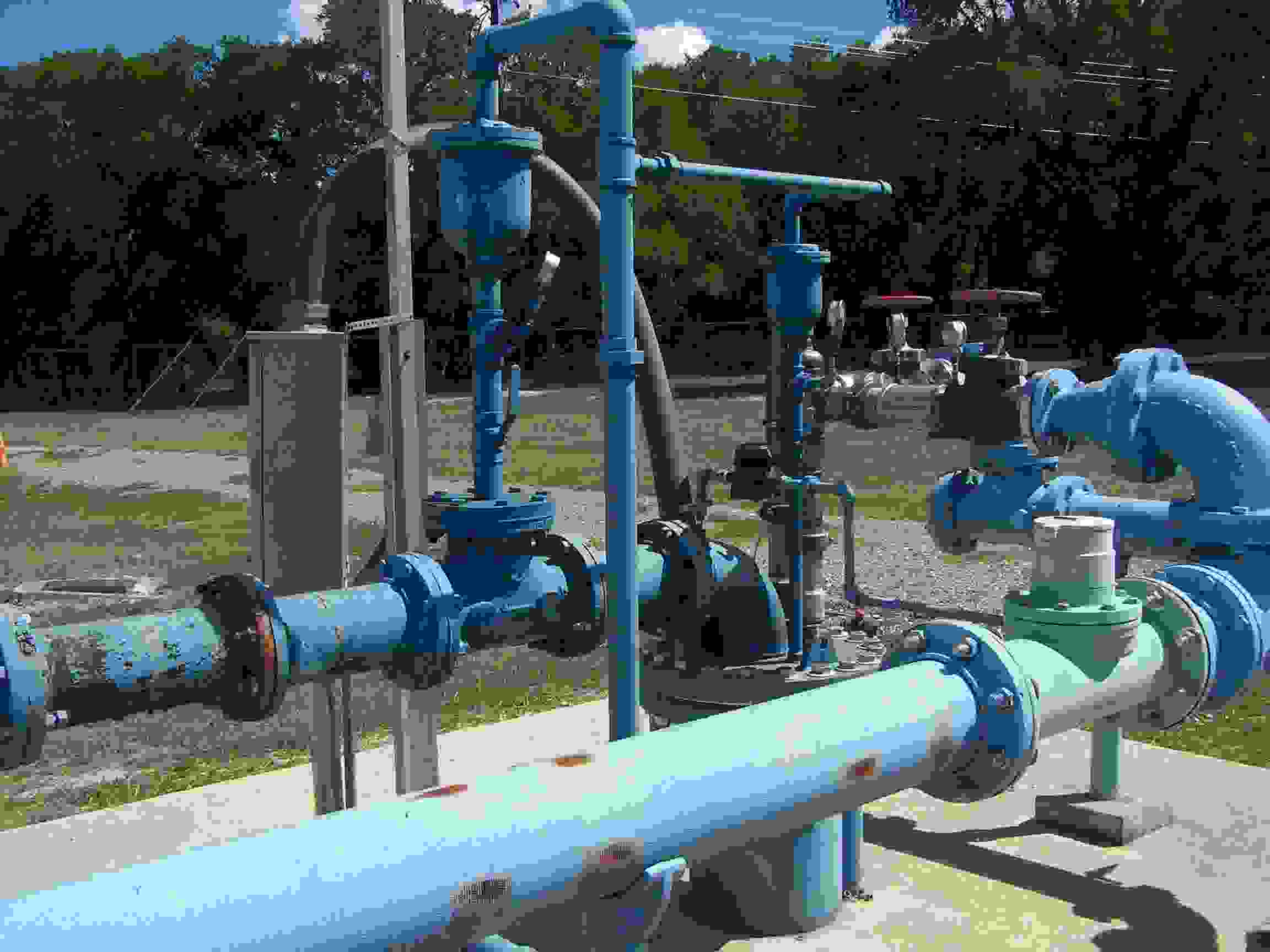
Mace added that San Antonio’s production capacity is 60 million gallons per day.
Kerrville has a target storage of about 4,600 acre-feet and a production capacity of 2.65 million gallons per day. After a third injection well becomes operational, the city’s production potential will increase to 3.65 million gallons per day, Mace said. Kerrville takes water from the Guadalupe River and puts that into the Lower Trinity Aquifer.
“Kerrville will tend to take excess water out of the river in winter months when demand for water is lower and inject it into the Trinity Aquifer,” he said. “Then it can take that water and pull it out during peak summer demand months.”
In addition to the San Antonio and Kerrville ASR projects, some say El Paso also has an ASR system, although others consider it to fall under the broader term of managed aquifer recharge, which also includes San Antonio and Kerrville’s systems.

“The reason I don’t consider El Paso strictly ASR is because ASR requires that they use the same wells to take the water out that they use to put the water in,” Mace said. “El Paso has injection wells and infiltration basins where it takes wastewater treated to drinking water standards and puts it into the aquifer, then lets it flow through the aquifer for a distance until it comes out of an existing production well.”
Finch said El Paso is using a model more similar to what Israel is using, where treated wastewater is pumped back out three months later and 50 miles down the road.
Why isn’t ASR used more in Texas?
The experts said ASR is not common in Texas because of several reasons: unfamiliarity with the technology, lack of education, concerns about regaining control of water once underground, lack of expertise and policies.
“A lot of times water providers have a ‘me second’ attitude toward new technology; they don’t want to be the first ones to do it because there’s risk associated with adopting new technology,” Mace said. “Texas is a rule of capture state, so someone could put a well next door and pull that water out. So you’ve gone through the effort to put drinking water down into an aquifer, and a neighbor could just as easily suck it out.”
Finch agreed that technology and Texas water policies are a concern as well as knowledge of the geology, economics and the potential for contamination.
Texas is a rule of capture state, so someone could put a well next door and pull that water out. So you’ve gone through the effort to put drinking water down into an aquifer, and a neighbor could just as easily suck it out.
Typically, the key technical issue that drives ASR, Finch said, is identifying a receiving geological formation that can take the water needed to be stored. For example, water could easily be put into the Edwards Aquifer, which has lots of caves and cracks in it, but the water would be lost quickly.
Mace said, “It’s like Goldilocks and the three bears: It’s the story of looking for the porridge that’s just right; you need to find the geology that’s just right to let the water in there but doesn’t let it flow away too quickly.”
Dr. Gretchen Miller, assistant professor of water resources engineering in Texas A&M University’s Zachry Department of Civil Engineering, agreed. “Knowing the chemical composition of the underlying formation, the injected water and the groundwater are essential prior to beginning ASR,” she said. “This information can be gained by taking rock cores and water samples and sending them for fairly conventional laboratory analysis.”
In addition, she said geophysical methods, such as those used in oil and gas exploration, hold a great deal of promise for determining aquifer suitability for ASR. Theoretically, storage capacity and the location of possible conduits for water migration could be determined with these types of tests once a target site is determined.
“In situations where freshwater is being injected into brackish aquifers, periodic geophysical surveys could possibly be used to track ‘bubble’ migration over time,” Miller said. She considers these methods to be a rich area for future ASR research and application.
“If you put the water down in the ground and it disappears, it’s kind of embarrassing to a water purveyor,” Finch said. “We don’t have a clear picture of what is going to happen. We have some consultants who are trying to do analyses for cities to say, ‘yes, you can put it down here, and here’s what’s going to happen,’ but for Texas, it’s a relatively new and untested technology.
“San Antonio Water System spent $250 million to build its ASR, so it’s not cheap, but it’s cheaper than a surface reservoir,” Finch said, “and if water disappeared or water got contaminated, that would set back the whole concept forever.”
Rep. Lyle Larson of San Antonio, who developed HB 3013, known as the ASR bill, during the 2013 Legislature, said another issue is some members of the 16 regional planning groups are unfamiliar with ASR.

“If you look at it from a historical perspective, surface water has been the preferred way to store water, but because of increased population, demand for water and evaporation, we’re seeing an unprecedented depletion in our surface water capacity,” Larson said. “A lot of that has to do with drought, but also on the demand for the water. We have to start figuring out some alternative approaches. That is why I filed the bill [HB 3013]; very few people in Texas were looking at ASR as a viable approach for storing water because of regulatory impediments.
“A lot of it is from an education standpoint. As people become aware that it’s being done, more and more people are encouraging us to pursue the legislation.”
Mace said other entities have considered ASR, including Austin, Corpus Christi, the Colony, Tarrant Regional Water District, Guadalupe Blanco River Authority, New Braunfels and Barton Springs Edwards Aquifer Conservation District, but in most cases they are continuing to look at it.
A lot of it is from an education standpoint. As people become aware that it’s being done, more and more people are encouraging us to pursue the legislation.
ASR elsewhere
There are more than 130 ASR systems in the country right now, Larson said, and more and more are being developed because people are tired of seeing so much water lost to evaporation.
“We lose between 5 to 6 million acre-feet of water a year to evaporation in the state from the more than 188 major water supply reservoirs we have,” Larson said. “If you look at all the states west of us and a lot of the states east of us, they aren’t building surface water reservoirs anymore; they are storing their water subterranean into aquifers to get 100 percent yield. If you build it right and engineer it properly, you won’t lose any of the water.”
He gave the iconic example of Lake Travis during the 2011 drought. As the water levels were falling and it was being projected that Texas was running out of water, the city of Austin used 166,000 acre-feet of water in the lake; the year’s evaporation total was 206,000 acre-feet, Larson said.
“So we lost more [water] to evaporation than we actually used in the driest year in the state’s history,” he said. “That should tell us that we probably ought to start operating like the states west of us do and store the water underground.”
Larson added: “If you look to the west of us, there is a proliferation of ASR going from California to Washington to Oregon and Idaho, back down to Nevada and Arizona and New Mexico; so, they are developing. Then east of us, if you go up the eastern seaboard, you have them from Florida and South Carolina all the way up the coast to New Jersey.”
He said Florida currently has 26 ASR facilities and is building 15 more. The largest ASR in the country is in Las Vegas and stores about 360,000 acre-feet of water — its winter allotment from Lake Mead — under the city.
“Because it’s situated in the desert, the city would have in excess of 50 percent evaporation, but it is storing its water [underground] and recovering it,” Larson said.
What research is being done?
In the late-1980s through the mid-1990s, Mace said TWDB received funding to help communities conduct planning studies to look at the potential for ASR at Kerrville, Laredo, the Brownsville Public Utilities Board and San Antonio, as well as the Sabine River Authority.
“In all cases, conditions looked favorable,” he said. “In fact, the Kerrville study turned into an actual project in Kerrville. That project has been a big success in Kerrville, where they’ve expanded it several times.”
Currently, Larson said, there are 13 study areas around Dallas for ASR sites — studies motivated by the 2011 drought’s evaporation losses due to the wind and sun.
“The good thing about locating it under a city like that is it can pass ordinances and restrict or put a moratorium on any well drilling in the incorporated area of the city, so the rule of capture wouldn’t come into play,” he said. “So there are some opportunities to build in that area.”
In all cases, conditions looked favorable. In fact, the Kerrville study turned into an actual project in Kerrville. That project has been a big success in Kerrville, where they’ve expanded it several times.
In addition, Larson said a subsidence issue in the Houston area needs to be evaluated geologically to see if the area is conducive to ASR, but there’s indications that if water is stored in the Gulf Coast Aquifer, subsidence would also stop in that area. Las Vegas was able to eliminate subsidence once ASR was in place.
Ben Blumenthal, Texas Water Resources Institute graduate student researcher, is conducting ASR research through the institute’s water assistantship program funded by the U.S. Geological Survey and W.G. Mills Endowment. He is currently researching and developing groundwater models of horizontal and vertical wells with the assistance of his advisor, Dr. Hongbin Zhan, professor of hydrogeology in Texas A&M’s Department of Geology and Geophysics.
“Basically, by having a horizontal well, you can have higher injection and extraction rates compared to the traditional vertical well,” Blumenthal said. “The idea is essentially more with less, more injection and extraction per horizontal well with less wells required to reach a given ASR capacity. Fewer wells could translate into a cost savings upon accounting for the increased cost of horizontal wells.
“However, we’re still working on how many vertical wells can be replaced by a horizontal well in addition to cost differences between vertical and horizontal wells,” he said. “Reducing the cost of ASR is what we’re trying to accomplish.”
Blumenthal also said using a horizontal well could expand the use of ASR in salty aquifers. Because of buoyancy, freshwater injected into a saline aquifer is pushed to the top of the host aquifer and spreads out. Therefore, when an entity begins to harvest ASR water, salt water is also extracted. Such buoyancy effects are minimized in lower permeability (slow) aquifers. Horizontal wells are better suited for such aquifers because horizontal wells have more contact with the host aquifer than a traditional vertical well, he said. Greater formation contact facilitates greater injection/extraction rates and thus more vertical wells are replaced by one horizontal well.
“Improving the economics of ASR will allow the use of this technology in more areas, especially those currently deemed economically infeasible due to host aquifer issues. Giving more communities access to ASR is the goal of our research,” Blumenthal said.
Recently a new ASR project, Aquifer Storage and Recovery for Texas – A Research and Extension Initiative, was funded by the Texas A&M Engineering Experiment Station as part of the Water Seed Grants. Miller, who is the project’s principal investigator, said the goal is to develop a working group of Texas A&M University System experts including Texas A&M AgriLife Research and Texas A&M AgriLife Extension Service personnel capable of addressing future ASR technical needs in Texas.
Giving more communities access to ASR is the goal of our research.
Finch is involved in this team with Miller that also includes experts in microbiology, environmental engineering, hydrogeology, groundwater monitoring, wastewater management, human health and water conservation.
“We don’t have as much expertise [in Texas] on ASR as is required; that’s what we’re trying to develop,” Finch said.
Miller said the project will develop new groundwater modeling tools to help predict the potential for ASR to affect water quality in an aquifer, assess using ASR in several major Texas aquifers, and conduct outreach through delivery of short-courses and presentations on ASR around the state, as well as development and distribution of educational materials on ASR.
“There are a lot of different issues to address,” Finch said. “What aquifer characteristics work best? What are the economics of ASR? What policies and legislation restrict use of ASR and what is needed to address them? What are potential contamination issues? What is the recovery potential of injected water and what will its condition be when withdrawn?”
“We hope that this will ultimately set the stage for the creation of an ASR center as part of the Water Conservation and Technology Center,” Miller said.
What does the future of ASR look like?
There seems to be no doubt that ASR research will continue, and the general consensus among experts is that ASR will begin to grow and become a more common technology for saving water in Texas’ future.
Finch hopes to accelerate the path toward having the expertise, research and teaching ability needed for ASR to grow in Texas.
“I hope we can continue our progress toward a day when we have that knowledge and are recognized as contributing the way we should be to getting the ASR technology used in the state,” he said. “There are a lot of opportunities out there, and it’s an important technology.”
“I see ASR as a viable alternative to a reservoir that loses 50 percent of the product to evaporation,” Larson said. “I think hopefully we’ll see a proliferation of ASR systems developing all over the state like you’re seeing in the western and eastern parts of our country.”
There are a lot of opportunities out there, and it’s an important technology.
Mace agreed. “I think it will become more prevalent in the future. Some folks have suggested that perhaps instead of storing all of our water in reservoirs, maybe we store some of that underground to remove it from the ravages of evaporation.”
Explore this Issue
Authors
Danielle Kalisek is the Assistant Director for Institute Operations for the Texas Water Resources Institute. In this role, she manages institute business, particularly the pre-award through account setup processes and state and designated accounts, she also coordinates communications and websites services and needs for the institute.


